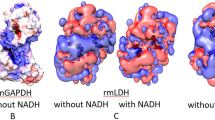Abstract.
The hyperthermophilic archaeum Thermoproteus tenax uses a variant of the Embden–Meyerhof–Parnas (EMP) pathway as the main route for carbohydrate metabolism. This variant is characterized by a reversible nonallosteric PPi-dependent phosphofructokinase and two glyceraldehyde-3-phosphate dehydrogenases differing in cosubstrate specificity, phosphate dependence, and allosteric behavior. Although the nonphosphorylating NAD+-dependent glyceraldehyde-3-phosphate dehydrogenase (GAPN; E.C. 1.2.1.8) fulfills exclusively catabolic purposes, the phosphorylating NADP+-dependent glyceraldehyde-3-phosphate dehydrogenase (NADP+-GAPDH; E.C. 1.2.1.13) exhibits anabolic features. The gene encoding the NADP+-GAPDH was cloned, sequenced, and expressed in Escherichia coli. The deduced protein sequence displayed 47%–53% sequence identity to archaeal phosphorylating GAPDHs. The kinetic parameters of the NADP+-GAPDH showed a clear preference for the reductive reaction with a 5-fold-higher specific activity in the reductive reaction as compared to the oxidative reaction and a 20-fold-lower K m for 1,3-bisphosphoglycerate as compared to glyceraldehyde-3-phosphate. Contrary to GAPN, the enzyme is not allosterically regulated. The coding gene overlaps by 1 bp with a preceding open reading frame coding for 3-phosphoglycerate kinase (PGK; E.C. 2.7.2.3). Northern analyses identified mono- and bicistronic messages of both genes in an equimolar ratio. Transcript levels and specific activity of NADP+-GAPDH and PGK were 3- to 4-fold higher under autotrophic conditions as compared to heterotrophic conditions, whereas transcript abundance and specific activity of GAPN remained constant in autotrophically and heterotrophically grown cells. The different regulation of the two counteracting glyceraldehyde-3-phosphate dehydrogenases is discussed with respect to the flux control of the T. tenax-specific EMP variant.
Similar content being viewed by others
Author information
Authors and Affiliations
Additional information
Electronic Publication
Rights and permissions
About this article
Cite this article
Brunner, N.A., Siebers, B. & Hensel, R. Role of two different glyceraldehyde-3-phosphate dehydrogenases in controlling the reversible Embden–Meyerhof–Parnas pathway in Thermoproteus tenax: regulation on protein and transcript level. Extremophiles 5, 101–109 (2001). https://doi.org/10.1007/s007920100181
Received:
Accepted:
Issue Date:
DOI: https://doi.org/10.1007/s007920100181




